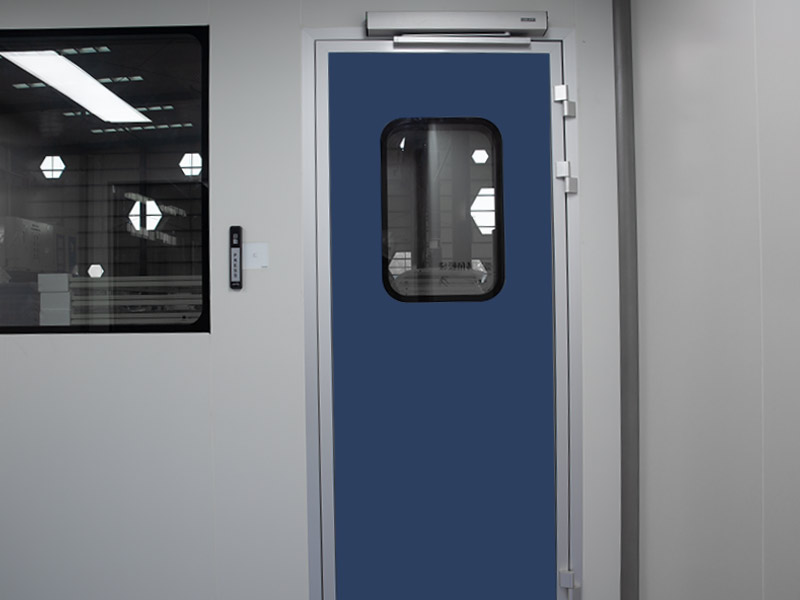Cleanroom Door
- These are customized and high-quality cleanrooms that are ready for use
- Interchangeable bin suitable for various kinds of materials
- Reasonable structure design, stable performance
Cleanroom Door : Product Description
The cleanroom doors allow you to control the flow of people, equipment, and materials in and out of cleanrooms. You can also effectively separate clean air from the dirty environment outside.
The cleanrooms doors have clean air that is filtered and treated before being released into a cleanroom.
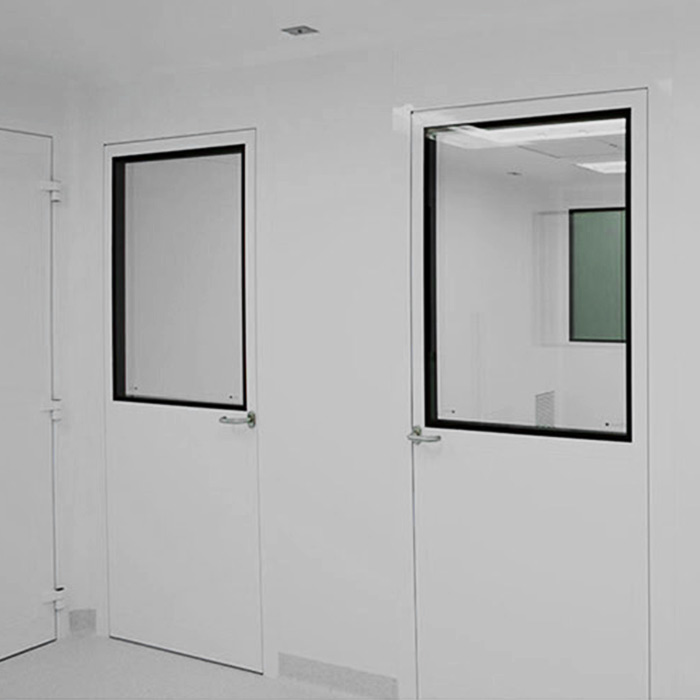
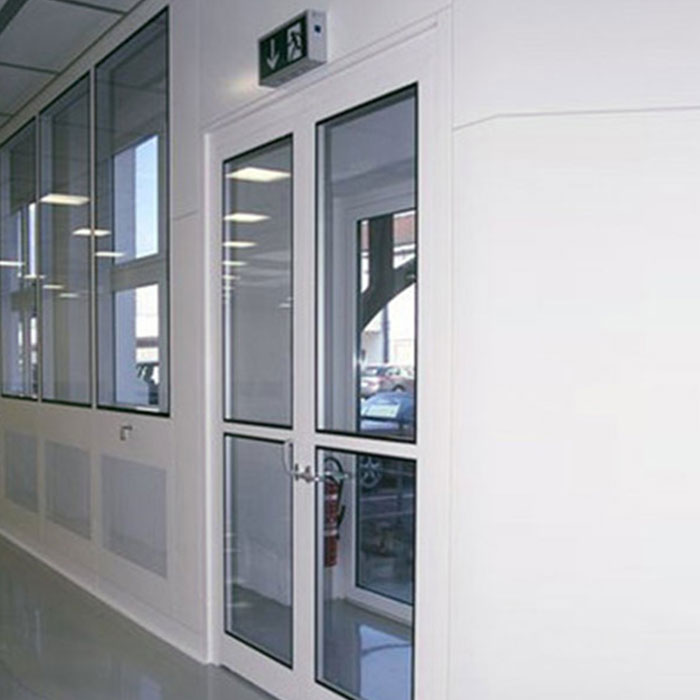
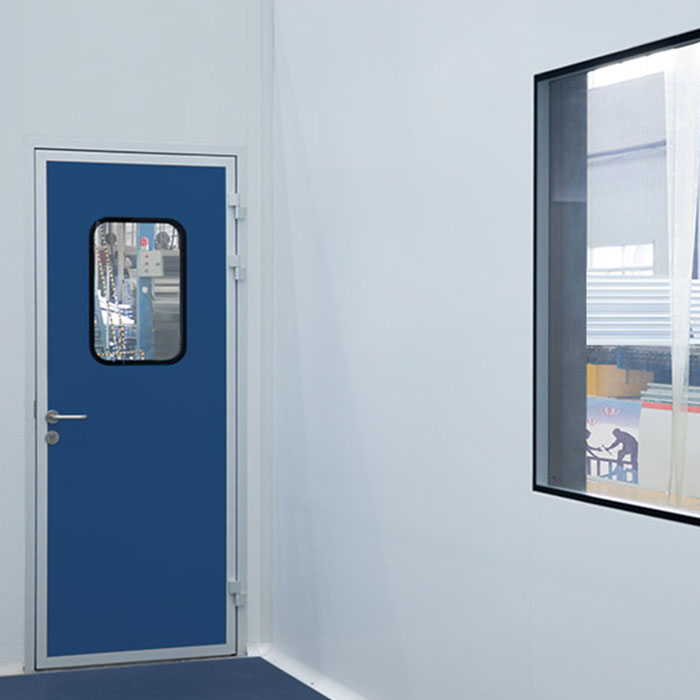
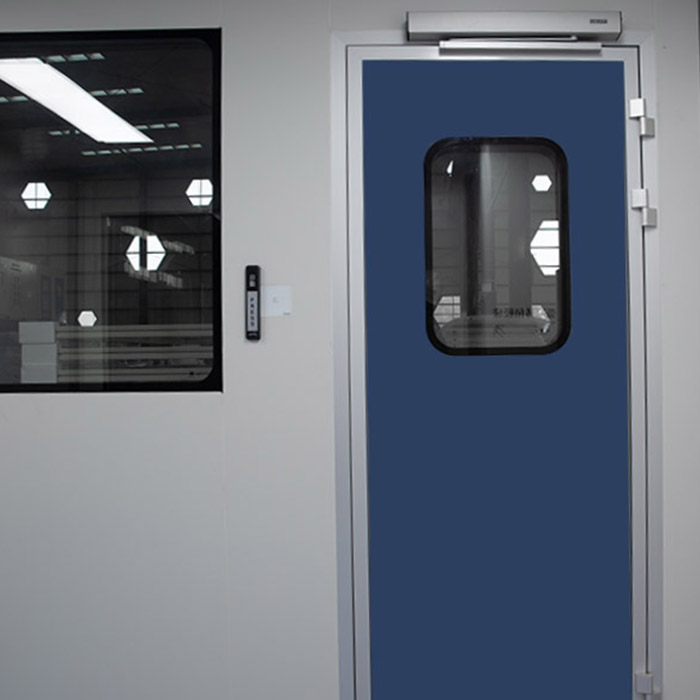
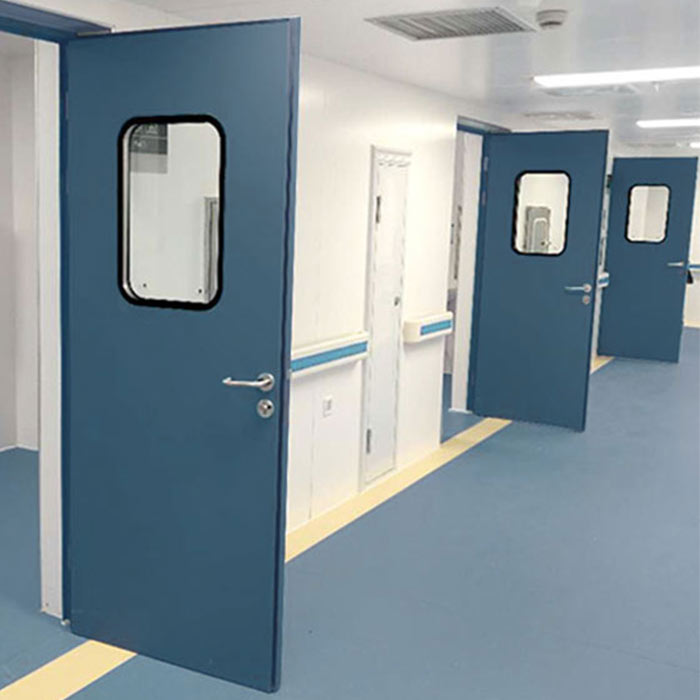
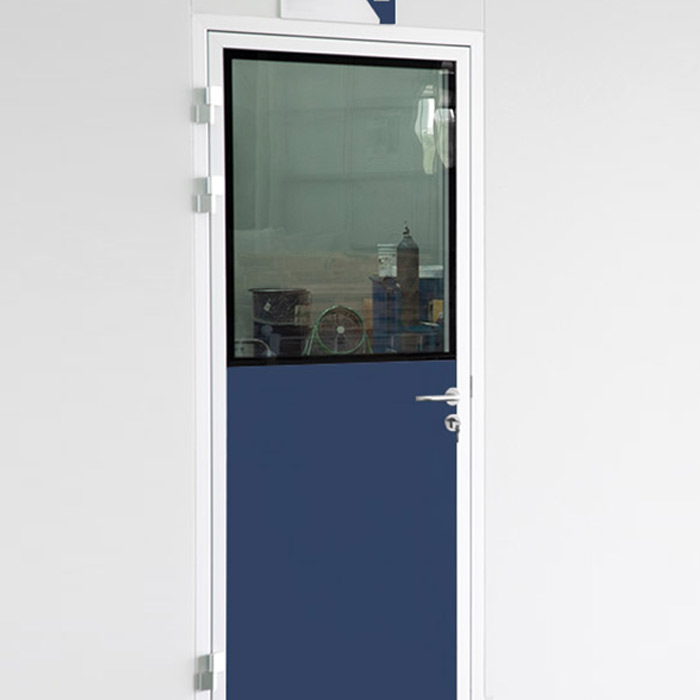
Paramenter of Cleanroom Door
◈ Stainless steel frame: cleanroom doors made of stainless steel to provide clean surfaces and clean air.
◈ Integrated clean ventilation: cleanroom doors have an integrated clean ventilation system to control the airflow in cleanrooms.
◈ Surface movement sensors: these cleanroom doors feature surface movement sensors that are activated by a person’s presence, thus preventing unexpected door movements from affecting cleanroom cleanliness.
◈ Industry standard cleanrooms: cleanroom doors are made according to industrial standards, so they provide a high level of cleanliness and contamination control.
◈ Stainless steel door panel: cleanroom doors have cleanroom door panels that are made of stainless steel for clean surfaces.
◈ Honeycomb clean air plenum: cleanroom doors have a clean air plenum honeycomb fiberglass filter, which provides a high level of cleanliness and protects your inner chamber from the outside environment.
◈ Medical grade door: cleanroom doors are also cleanroom medical grade.
◈ Optional clean air plenum: cleanroom doors have an optional clean air plenum that you can install into cleanrooms when you need a higher cleanliness level in cleanrooms.
◈ Cleanroom doors are commonly used in pharmaceuticals, chemical industries, medical facilities cleanrooms, clean manufacturing facilities, clean energy, clean water treatment plants.
◈ They are also used in clean indoor spaces such as cleanrooms and clean cubicles where they offer a safe way to transfer people and goods while efficiently controlling the flow of clean air from the cleanroom into dirty areas.
Strong and durable
◈ Easy to install.
◈ Safe cleanrooms.
◈ Made according to industrial standards cleanroom doors.
◈ High cleanliness levels in cleanrooms cleanroom doors.
◈ Can be customized and integrated into cleanrooms cleanroom doors.
More Details of Cleanroom Door
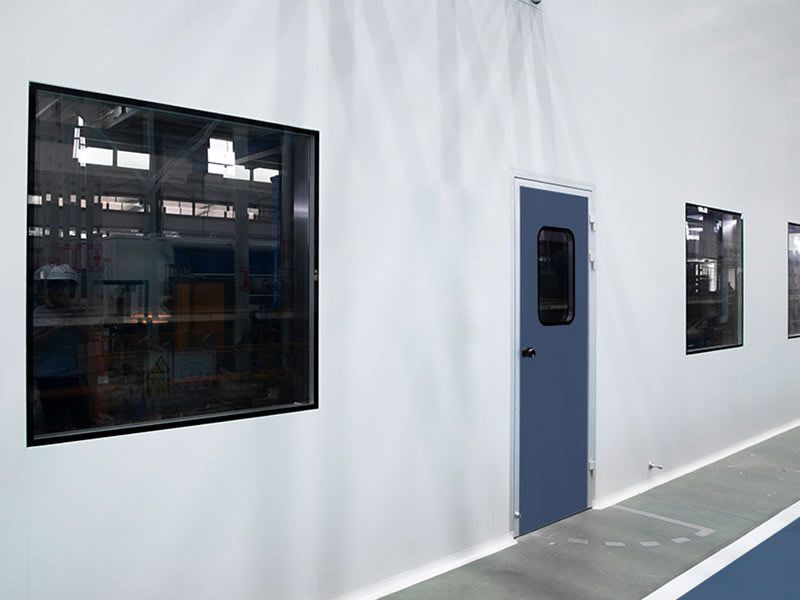
Model 123 Cleanroom door
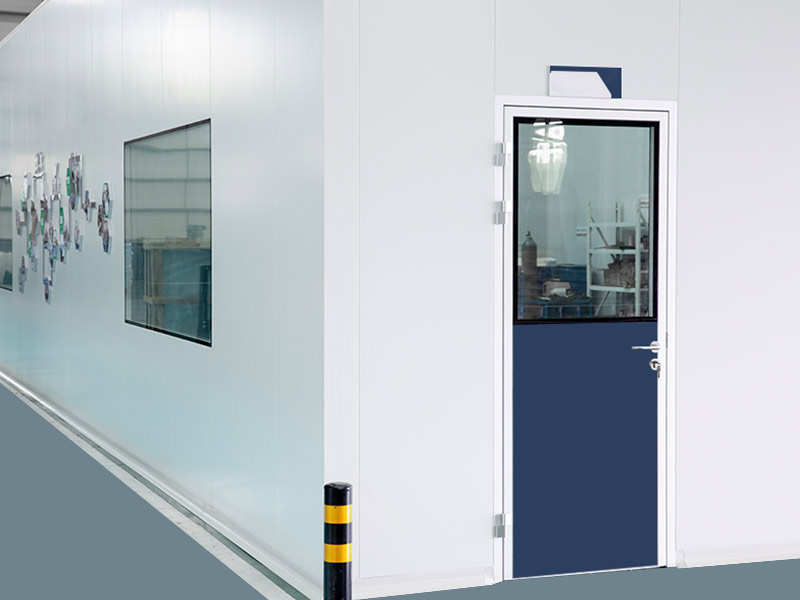
Model 124 cleanroom door
Any Question About Senieer Cleanroom Door
Why Global Company Trust Senieer
Top Quality Factory Price
We have a quality control department to verify each product at different phases, from the procurement of parts to finished products
As Your Layout, Customize Machine
According to your layout, we can suggest the best capacity and type for you, customize cleanroom door for you
Cleanroom Door Consult & Design Service
Save energy resource for you, professional engineers can improve the best processing solution. We have the experience to help add a tremendous amount of value to your project
ISO.CE Standard Qualified
We successfully obtaining the ISO9001:2008 certificate and CE security management system certificate, this is significant for Senieer in building enterprise image
Cleanroom Door Training & Maintance Service
Free cleanroom door training & maintenance service for you, we will provide your team in-depth training on safe operation and cleanroom door maintenance
Cleanroom Door Installation Service
Senieer offers cleanroom door installation & commissioning service for production products, your cleanroom door and control systems are qualified based on the GAMP life-cycle
Cleanroom Doors Complete Buying Guide for Importers
Let’s dive right in:
- Chapter 1:What is a Cleanroom Door?
- Chapter 2:How do Cleanroom Doors Work?
- Chapter 3:Cleanroom Door Construction
- Chapter 4:How to Install Cleanroom Doors?
- Chapter 5: Components of a Cleanroom Door
- Chapter 6:Cleanroom Design
- Chapter 7:Cleanroom Door Material
- Chapter 8: Cleanroom Door Configuration
- Chapter 9: Cleanroom Door Hardware
- Chapter 10:Terms to Know When Buying Cleanroom Doors
- Chapter 11:Factors to Consider when Buying Cleanroom Doors
- Chapter 12:Choosing Cleanroom Door Manufacturer in China
- Chapter 13:Frequently Asked Questions About Cleanroom Doors

Cleanroom doors are completely different from ordinary doors. They are specially designed and constructed to meet the needs of the cleanroom environment.
After you have built a cleanroom, the next big task will be getting the right door. Buying cleanroom doors is not as easy as compared to the other doors. You need to equip yourself with technical information about this type of door.
In this guide, we are going to enlighten to on how to buy the best cleanroom doors.
Chapter 1: What is a Cleanroom Door?
We can simply define a cleanroom door as a type of door that is used in the cleanroom.
A cleanroom is an enclosed work area where sensitive operations occur. These areas have been established to maintain the highest level of cleanliness.
If you have never seen a cleanroom before, then it is time for you to drop by one of these facilities. You will find that the occupants of this facility look like astronauts walking in their spacesuits. This is because they are highly protected from any form of contamination and airborne particles.
A cleanroom door is a special door with much more stringent requirements than the usual doors. The size of the air particles that can pass through this type of door must be very small to avoid cross-contamination in cleanrooms and other controlled environments. It is advisable for you to check out the quality of these housing units before purchasing them.
Whenever you build a cleanroom, the next thing that you will think about is a cleanroom door. It has been proved that cleanroom doors are different from other types of doors. They must meet very stringent requirements to avoid contamination in cleanrooms and any other controlled environment.
Chapter 2: How do Cleanroom Doors Work?

The working principles for cleanroom doors have been explained below.
For a cleanroom door to work effectively, it must be completely tight and locked in place so that no particle can get through. The area around the door’s frame must also be checked to see whether any particles are present. If they are present, then the area must be cleaned and vacuumed before the cleanroom door is installed.
The purpose of cleanroom doors is to avoid contamination at all costs. This is why they must be completely tight to protect the cleanroom from any type of contaminants.
Chapter 3: Cleanroom Door Construction
Cleanroom doors are manufactured using different types of construction materials.
The construction material for the cleanroom door will depend mainly on the material that has to be transported into the cleanroom.
Some of these materials may pose a danger or contamination risk if they are not handled in the right way. If you need to transport any of these materials, then it is advisable for you to use a sealed container to avoid any kind of contamination.
For your information, cleanroom doors are not very cheap items. These products have been manufactured with the best quality materials to avoid any form of contamination. If you want to save some cash, it is advisable for you to buy directly from a cleanroom door manufacturer.
Chapter 4: How to Install Cleanroom Doors?
For effective installation of cleanroom doors, you should follow these procedures.
– Drive along wood screw through the wall and into a stud on each side at 1/2″ from the top and bottom. Use the manufacturers’ clean room door gasket with pre-applied adhesive tape to attach the cleanroom door.
You can easily install a cleanroom door on your own by following these guidelines. They are very easy to install, and you do not need any tools to complete this task.
The manufacturers of cleanroom doors always provide easy installation manuals that you can follow for precise results.
Chapter 5: Components of a Cleanroom Door
The cleanroom door has a very special design. It consists of some major components including:
– Door Frame – The door frame will consist of the top, bottom and sides of the cleanroom. All these pieces must fit together perfectly to ensure that there are no gaps for any type of particles to get through.
– Cleanroom Door Hinges and Locks – Another important part is the hinges and locks used for opening and closing the cleanroom door. They must be made from stainless steel or other materials that do not pose a contamination risk when they are touched by staff wearing dirty gloves.
– Gasket Seals – The gasket seals must meet stringent standards to prevent any form of particle movement in or out of the cleanroom.

– Electricity for Cleanroom Door Control – The cleanroom door must be controlled from the outside to ensure that nobody enters or exits the cleanroom without authorization. This is a safety feature that has been installed to protect all occupants of the cleanrooms.
– Cleanroom Door Controls – All cleanroom doors are equipped with some kind of controls for the door to function properly.
– Viewing Windows – Cleanroom doors have viewing windows so that you can see through them into the cleanrooms. These may be protected by gaskets, filters, and other materials with similar properties.
Chapter 6: Cleanroom Design
The design defines the shape and dimensions of the cleanroom door. It also defines whether the cleanroom door can be moved or not. Some cleanroom doors are manufactured with hinged construction which makes them movable while others are fixed.
A cleanroom design is different from a normal door design. In most cases, cleanroom door designs are more complicated. The following three factors must be taken into consideration:
– Particle size air leakage rate
– Contamination avoidance and reduction requirements (CARR)
– Water penetration resistance under preferred test conditions of 70°F (21°C) at 50% relative humidity for 30 minutes with a water head of 12 inches (305 mm) above the threshold on the inside face of the product when tested in accordance ASTM E 331 – Type 1 and conditioned at this temperature and humidity for 4 hours before testing.
The design of cleanroom doors is different from normal door designs. These types of doors are more complicated than the usual ones because they must comply with stringent requirements to protect cleanrooms, controlled environments, etc. from any form of contamination.
Chapter 7: Cleanroom Door Material
Cleanroom doors are made using different materials such as steel, fiberglass, and plastics. The material used will depend on the type of facility that you want to build in your area. For instance, if you want a facility that manufactures pharmaceutical drugs or food items that require high-level hygiene then you should use stainless steel for building cleanroom doors to avoid any contamination problems.
The material used for cleanroom door construction will also depend on the type of product that needs to be transported into the cleanroom. Some products are a danger to health if they are not handled in a controlled environment.
Before you buy a cleanroom door, confirm the type of material that has been used to construct it. If the door is made of steel, you should confirm that it has been manufactured using stainless steel which is resistant to chemicals as well as high levels of heat.

Steel Cleanroom Doors
These types of doors are designed for use in facilities that work with chemicals or pharmaceutical drugs that react with oxygen and produce fire when combined. The main advantage of using these doors is that they are a lot stronger than fiberglass or plastic units.
Fiberglass Cleanroom Doors
These types of doors are easy to install and maintain. However, their main drawback is that they are not strong enough to withstand the force created by pushing or pulling heavy products when compared to steel cleanroom doors. These types of doors are best suited in places that manufacture food items that need to be transported from one place to another.
Plastics Cleanroom Doors
These types of doors are normally used in the production of electronic products. They offer high levels of protection against chemicals as well as other contaminants such as dust particles. However, they are not very strong when compared to steel or fiberglass units.
Chapter 8: Cleanroom Door Configuration
There are different types of cleanroom doors available in the market depending on their construction materials and features. However, they fall into two main categories which include swinging and sliding configurations. Both these door types come in an array of configurations that can be used to suit a wide variety of facilities.

Swinging Cleanroom Doors
These types of cleanroom doors are normally used in areas that require natural ventilation. They are made using stainless steel and use tightly fitting seals to prevent contamination from entering the cleanroom or facility.
One advantage of this door type is that they can easily be installed on any wall since they do not have a specific back or side.
Sliding Cleanroom Doors
These types of doors are normally used in places where convenience is required when transporting products from one place to another. They can be easily installed on a cleanroom wall, but they need to be fitted with tracks that run along the floor and ceiling hence limiting their use to smaller cleanrooms.
Chapter 9: Cleanroom Door Hardware
Cleanroom doors manufacturers use different types of hardware depending on the type of cleanroom door they manufacture. Normally, sliding cleanroom doors have more hardware components than swinging cleanrooms since these types of doors run along tracks. However, each component is designed to be robust enough as well as convenient to use.
Another type of hardware component that is used for cleanrooms is the lock. These types of locks are normally manufactured using stainless steel to ensure that they do not corrode, hence providing durability and longer life to the unit. There are different types of cleanroom locks available on the market, which include cam locks, key locks, card locks, and digital locking systems.
Cam locks are normally used for cleanroom doors that have a flush finish. These types of locks can be easily opened using a card or an identification tag fitted with magnetic strips. It is important to note that all cleanroom doors need regular maintenance since the locks may jam if they are not maintained in time.
Key locks are normally used for cleanroom doors with a raised finish. This type of hardware is designed to fit into the door groove which prevents them from being tampered with or damaged when compared to cam locks. However, these types of the lock take longer than other types of units since they require the use of keys unlike card locks and identification tags.
Digital locks can be programmed with different access codes to suit various cleanrooms. They are convenient since they allow the entry of multiple users into cleanrooms at one given time. However, these types of locks require a constant power supply for them to operate properly and cannot be used in places that do not have a reliable source of electricity.
Chapter 10: Terms to Know When Buying Cleanroom Doors
There are different types of cleanroom doors available on the market. The choice of a specific type normally depends on the facility and customer’s preferences. Some of the common types that are used include:
1- Sliding Cleanrooms
2- Rolling Walls
3- Swing Doors
4- Sidelight & Toplight Doors
5- Sliding Chains
6- Cleanroom Curtains
7- Glazed Walls
Sliding cleanroom doors
Sliding cleanrooms are normally used for smaller facilities, which have limited space. These units are convenient to use since they can be fixed on a wall and pulled open using tracks on the floor and ceiling. They are normally fitted with a locking mechanism to ensure the safety of personnel and equipment.
Rolling cleanroom doors
These types of cleanroom doors are normally used for large facilities such as in pharmaceutical, food processing, and medical industries. Rolling wall units come with multiple glass panels which allow the entry of natural light into the facility when they are opened. They also help to balance air pressure while preventing infiltration by dust particles.

Swing cleanroom doors
Swing cleanrooms are typically used for front entry cleanrooms since they allow doors to open inwards or outwards depending on the specific needs of the customer. These types of cleanrooms come with full-height glass panels which might not provide safety when people lean against them. The panels can be made using tempered, laminated, or toughened glass.
Sidelight and top light cleanroom doors
These cleanrooms are normally available as double doors with each door opening in a different direction, unlike swing doors. These types of units have panels that can be lifted for easy cleaning and maintenance.
Some models also come with interlocked panels that prevent the overall unit from moving while personnel or equipment is entering or exiting the cleanroom.
Cleanroom curtains
Cleanroom curtains are beneficial since they can be used for small cleanrooms that do not require a permanent structure. They are easy to install and use, regardless of the level of contamination. The only drawback is that these types of cleanrooms require frequent cleaning since they leave some gaps where dust might infiltrate into the cleanroom.
These cleanrooms are fitted with doors that allow them to slide open and closed. The type of locking mechanisms used might differ from one cleanroom to another depending on the needs or preferences of the customer.
It is clear that cleanroom doors are available in a variety of models, which vary based on design and functionality. The door material might be made using aluminum or steel depending on the specific cleanroom requirements. There are adjustable and rigid models available which come with a good range of features and benefits.
Similarly, you should know that cleanroom doors are available in a variety of sizes and models depending on the specific requirements of the customer. It is important to consider the dimensions of the cleanroom and determine whether it will be fitted with sliding, swing, or rolling walls before placing an order.
Chapter 11: Factors to Consider when Buying Cleanroom Doors
Design
This is the most important factor to consider when buying cleanroom doors. It normally determines whether a door can be used in a cleanroom. To meet the required standards, all cleanroom doors should have smooth surfaces and be fitted with an anti-static coating.
Different types of cleanrooms have different design requirements which include laminar flow units that are normally clean, sterile, and unoccupied.
Dimension
The dimension of the cleanroom door should be determined based on the size of the room where it will be used. Standard cleanrooms have measurements that are multiples of 1 meter, meaning that their doors should also have similar measurements. This is important because it ensures that the air flows from one room to another without any interruption.

Cleanliness
This is another factor that should not be overlooked when buying cleanroom doors. The level of cleanliness required for the door to meet the set standards will depend on the type of cleanroom you are using it for.
Cleanrooms normally have three classes which include class 100, class 10,000, and class 100,000 depending on their cleanliness levels.
Ultraviolet door coating
Cleanroom doors are normally coated with ultraviolet protective layers. The layer is important since it protects the cleanroom door from damages that can be caused by exposure to sunlight such as discoloration and corrosion. Currently, there are two types of ultraviolet protective coatings available on the market which include acrylic and polyurethane.
Construction
Cleanroom doors are normally manufactured using different materials depending on the required standards. The most common types of construction include solid or honeycomb core, as well as material such as plywood and metal which may be used for hardware components.
Material
Cleanroom doors are normally manufactured using stainless steel to ensure that they do not corrode, hence providing durability and longer life to the unit. Compare the different cleanroom door materials that are used to make cleanroom doors before deciding on the right one for your needs.
Price
Before buying cleanroom doors, ensure that you have a budget in place. There is an abundance of different types of cleanrooms on the market which range from entry-level to whole room class units.
If you are operating on a tight budget, ensure that you select cleanrooms from the entry-level category. However, if you are operating on a higher budget, ensure that you buy a unit from the whole room class category.
User access:
There are different types of cleanrooms available that can be accessed by one person or more than one person at a time depending on their design and configuration. The access is usually determined by the type of lock that is used as well as the number of doors that are available.
Locks
As mentioned earlier, cleanroom doors have locks that can be key-operated or digital depending on your preferences and budget. The different types of locks include cam locks, mortise door handles as well as push bars among others.

Ventilation
This is also one of the most important factors to consider when buying cleanroom doors. The level of ventilation required for a particular room will determine what type of cleanroom door you buy as well as the types of filters that are used on it.
Filter
Cleanroom doors have high-quality HEPA filters which are normally removable and replaceable whenever they get dirty. They are absent in entry-level cleanrooms which should be used for limited access or areas that are not critical when it comes to cleanliness.
Anti-static coating
Most of the cleanroom doors on the market have anti-static coatings which protect them against electrostatic charges as well as provide improved resistance to scratches and dents that can be caused by the debris.
ISO door classification
This is another important factor to consider when buying cleanroom doors. This will determine whether your unit has the highest or low level of cleanliness required in a particular room. Some of the most common ISO cleanroom classifications include class 5, 10, and 100 among others.
GMP classification
GMP stands for Good Manufacturing Practices. The cleanroom doors that fall under this category are normally used in manufacturing facilities where products such as pharmaceuticals are manufactured. They are designed to provide airtight seals which prevent the release of contaminants into the environment when exposed to outside contaminants.
Chapter 12: Choosing Cleanroom Door Manufacturer in China
When it comes to cleanroom door manufacturers in China, different types of manufacturers are available on the market. When choosing a particular manufacturer for your cleanroom doors, ensure that you consider various factors including:
Pricing
Price is one of the determinants when selecting a particular supplier for your cleanroom doors. Ensure that you compare the prices of different manufacturers as well as get estimates from your supplier which will help you know if the price you are getting is good or bad.
Product quality
Another determinant when choosing a manufacturer to supply cleanroom doors is product quality. It is important to choose a manufacturer that has been tested and verified before use; this ensures quality products.

Timely delivery
Timely delivery is another important factor to consider when choosing cleanroom doors manufacturers. Ensure that you do some research on the different types of manufacturers and find out which one delivers products within a short period of time.
You should also ensure that your cleanroom door supplier provides you with a timeline through which they will deliver their products to you.
-Customer support
Customer support is another important factor to consider when choosing a manufacturer for cleanroom doors. The amount of effort that your chosen supplier puts in to provide you with quality products should also be put into providing you with superior customer service.
This will ensure that all your concerns are addressed and that you get a chance to ask questions about your products as well as ask for any clarifications.
– Reliable
A reliable manufacturer is one of the most important factors to consider when choosing a supplier for cleanroom doors. Concerning this, the supplier should be able to provide cost-effective quality products without compromising on safety and cleanliness levels in your room.
Once you find the manufacturer that meets these requirements, proceed to buy the best cleanroom doors.
Chapter 13: Frequently Asked Questions About Cleanroom Doors

-Do I need a cleanroom door?
Ans: yes. If you are operating in an environment that is not clean or does not require full protection from airborne contaminants, it is highly advisable to install a cleanroom door as well as other airlocks.
– What factors should I consider when buying cleanroom doors?
Ans: some of the most common factors that you should consider include cleanliness level, type of lock as well as color, and design.
– How much do cleanroom doors cost?
Ans: this will depend on the type of material that is used to make them as well as their design and size. Expect a wide range in price when buying cleanroom doors.
– Are cleanroom doors expensive?
Ans: this will depend on the size, material that is used as well as their design and configuration. Cleanrooms are relatively more expensive than traditional door units for normal rooms. However, they are less expensive in comparison to standard airlocks.
– What is a Class 100 cleanroom door?
Ans: this refers to a cleanroom door that has no more than 100 particles per cubic foot. It is also referred to as a class ten cleanroom door especially in Europe. This type of cleanroom door should be used when there are very stringent requirements regarding contamination levels but not relatively high compared to class 1000 or higher units.
– What is a class 1000 cleanroom door?
Ans: this refers to a cleanroom door that has less than about 100,000 particles per cubic foot. This type of cleanroom door should be used when there are high stringent requirements regarding contamination levels and they are more commonly found in areas where pharmaceutical products are manufactured.
– What are ISO cleanroom doors and what is their classification?
Ans: ISO stands for International Organization for Standardization. The cleanroom doors that have an ISO designation refer to those that comply with the specifications set by this organization. Their designations include classes 1, 2, 3, 4, 5.1, 5.2 among others which are also dependent on the type of cleanroom in which they are to be used.
– What is a class 1 cleanroom door?
Ans: This refers to a cleanroom door that has an ISO designation that falls within Class 1 and is employed when there are very stringent requirements regarding contamination levels. They are normally used in manufacturing facilities where pharmaceutical products are manufactured.
-What material is used on cleanroom doors?
Ans: there are various types of cleanroom door materials including aluminum, stainless steel, and plastic.

The most common is aluminum because it offers an excellent balance between strength, insulation, and fire protection. Other metals are also used depending on their specific characteristics but they may not be as effective in the containment of contaminants
-Our cleanroom doors different from regular doors?
Ans: cleanroom doors vary mostly in terms of materials that are used to manufacture them as well as their other characteristics. However, one major difference is that cleanroom doors are manufactured in a way where they all have very low levels of contaminants
– How do I maintain cleanroom doors?
Ans: it is advisable to clean them when dirty and also lubricate the moving parts when required. Some manufacturers may advise you to unload the cleanroom door when not in use and also put it into storage.
– How often should cleanroom doors be inspected?
Ans: this will depend on their location as well as cleanliness levels at that particular time and may vary. However, it is advisable to check them every once a month.
Conclusion
Cleanroom doors are a necessity in any cleanroom where stringent requirements regarding contamination levels are required. They vary mostly in terms of materials used to manufacture them and other characteristics including design, configuration as well as their ability to keep contaminants out.
You should also buy from the best cleanroom manufacturer in China.










